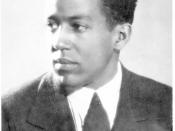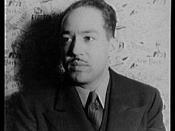James Atatah Vasbinder 1302 December 4, 2000 Research Paper The Stairway of Blues Throughout the history of American Literature, there have been many great writers, especially some of the African American writers. They have done quiet a few prize winning masterpieces. One critic once said "African American writing is a racial art"ÃÂ (Tobin 1). Langston Hughes is one of the best-known African American writers. His work not only inspires people to conquer the inevitable, but it shows the African American experience and how someone can benefit from the lesson that each character faces in his writings. The use of extended metaphors, dance, and musical themes is well known throughout Hughes work. He uses these tools to show the ability many blacks had in challenging obstacles of hatred and discrimination, and how they preserve an immeasurable level of perseverance in overcoming the obstacles. (African American history seen in Poetry 1) The following analysis will show how Hughes uses oppression, tradition, and racial theme in the connection between two of his masterpieces The Weary Blues and Mother to Son.
In Mother to Son, Hughes uses an extended metaphor to show the oppression African Americans faced at the time. Hughes writes, "It's had tacks in it, and splinters, and boards torn up."ÃÂ Hughes uses this to show that the character has not had a smooth walk through life. Hughes never reveals the mothers place on the stairway. She could be going up or down that dangerous stairway of life. She could even be thinking about life and how it has treated her. The stairway in the piece is supposed to be crystal, which symbolizes rich class. R. Baxter Miller interprets the "tacks"ÃÂ and "splinters"ÃÂ in this poem as "threats to the mother's body and soul."ÃÂ (Qtd in Poetry for Students) Baxter's comment suggests...


